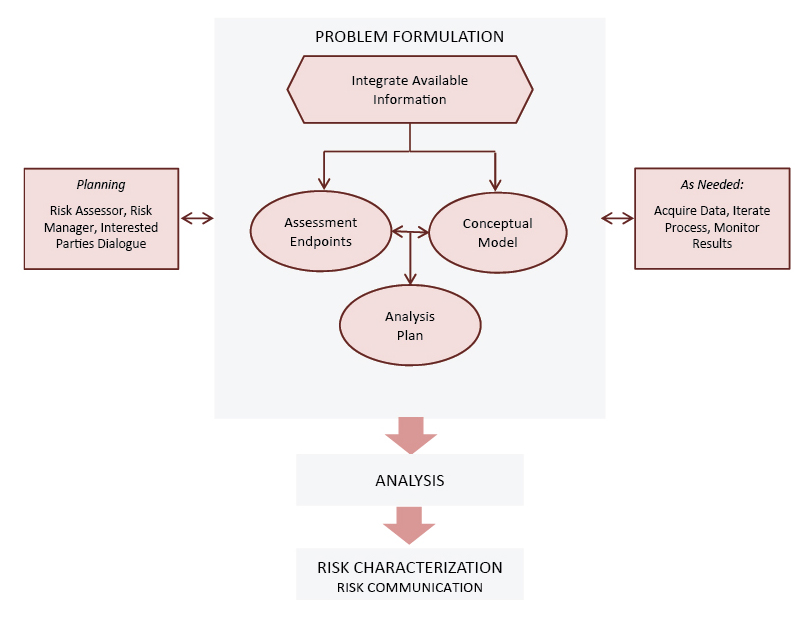Phases of ERA - Planning and Problem Formulation
Planning
 As described the Guidelines for Ecological Risk Assessment (U.S. EPA, 1998), planning is the initial phase of an ecological risk assessment (ERA). During planning, risk managers and risk assessors define the goals, scope, and timing of a risk assessment. These may include government officials, politicians, ecologists, toxicologists, wildlife biologists, chemists, statisticians, engineers. They also identify the resources that are available and necessary to achieve the goals.
As described the Guidelines for Ecological Risk Assessment (U.S. EPA, 1998), planning is the initial phase of an ecological risk assessment (ERA). During planning, risk managers and risk assessors define the goals, scope, and timing of a risk assessment. These may include government officials, politicians, ecologists, toxicologists, wildlife biologists, chemists, statisticians, engineers. They also identify the resources that are available and necessary to achieve the goals.
After the planning phase, problem formulation process begins.
Problem Formulation
Problem formulation is a process for generating and evaluating preliminary hypotheses about why ecological effects have occurred, or may occur, from human activities (U.S. EPA, 1998). During problem formulation,
- the purpose for the assessment is articulated,
- the problem is defined, and
- a plan for analyzing and characterizing risk is determined.
As described in U.S. EPA’s Guidelines for Ecological Risk Assessment (U.S. EPA, 1998) problem formulation may include the integration of available information on sources, stressors, effects, and ecosystem and receptor characteristics. The table below summarizes information that may be considered during problem formulation.
Sources: OSWER, 1997; U.S. EPA Region 5, 2011; U.S. EPA, 1991; 1998.
Using this information risk assessors can develop: assessment endpoints and a conceptual model. These two products are needed to complete an analysis plan.
- According to U.S. EPA’s Guidelines for Ecological Risk Assessment (U.S. EPA 1998) an assessment endpoint is “an explicit expression of the environmental value that is to be protected, operationally defined by an ecological entity and its attributes.” Assessment endpoints include two elements: identification of the specific receptor that is to be protected (e.g., species, community, ecosystem), and a characteristic about the receptor of concern that is important to protect (e.g., survival, growth, reproduction).
- The Guidelines for Ecological Risk Assessment (U.S. EPA 1998) define a conceptual model as “a written description and visual representation of predicted relationships between ecological entities and the stressors to which they may be exposed.” The conceptual model consists of two components: a set of risk hypotheses that describe the predicted relationships among stressor, exposure, and assessment endpoint and a diagram that illustrates these relationships.
- The analysis plan summarizes what has been done during problem formulation and targets those hypotheses that are likely to contribute to the risk. It also evaluates the risk hypotheses to determine how they will be assessed and develops the assessment design. It identifies data gaps and uncertainties and determines which measures will be used to evaluate the risk hypotheses. It also ensures that the planned analyses will meet the risk managers' needs.
Phase 1 of the ERA: Planning and Problem Formulation
Goal
Articulate the purpose for the assessment, define the problem, and make a plan for analyzing and characterizing risk.
Who is involved?
- Risk assessors and other professionals who bring expertise relevant to the locations, stressors, ecosystems, scientific issues, and other expertise as needed, depending on the type of assessment.
- Risk managers—individuals and organizations who have the responsibility or authority to take action or require action to mitigate an identified risk.
- Other interested parties, or “stakeholders” that may include Federal, State, tribal, and municipal governments, industrial leaders, environmental groups, small-business owners, landowners, and other segments of society concerned about an environmental issue at hand or attempting to influence risk management decisions.
Approach
- Planning
- Identify the interested parties: risk assessors, risk managers, stakeholders.
- Begin the planning dialogue between risk assessors and risk managers.
- Determine if a risk assessment is the best option for supporting the decision.
- Come to agreement on the goals, scope, and timing of a risk assessment and the resources that are available and necessary to achieve the goals.
- Problem Formulation
- Refine objectives for the risk assessment.
- Evaluate the nature of the problem: gather available information on stressor sources and characteristics, exposure opportunities, characteristics of the ecosystem(s) potentially at risk, and ecological effects.
- Select assessment endpoints
 assessment endpointsAn explicit expression of the environmental value to be protected, operationally defined as an ecological entity and its attributes. that identify specific receptors to be protected and characteristics about the receptors that are important to protect.
assessment endpointsAn explicit expression of the environmental value to be protected, operationally defined as an ecological entity and its attributes. that identify specific receptors to be protected and characteristics about the receptors that are important to protect. - Develop conceptual models
 conceptual modelsA written description and visual representation of predicted relationships between ecological entities and the stressors to which they may be exposed. that describe predicted relationships among stressors, exposures, and assessment endpoints.
conceptual modelsA written description and visual representation of predicted relationships between ecological entities and the stressors to which they may be exposed. that describe predicted relationships among stressors, exposures, and assessment endpoints. - Develop an analysis plan that includes a delineation of the assessment design, data needs and uncertainties. The plan also includes measures that will be used to evaluate the risk hypotheses, and methods that will be used for conducting the analysis.
- Describe pathways and relationships identified during problem formulation that will be pursued during the analysis phase of the ERA. Ensure that the planned analyses will meet risk manager needs.
Products
- Planning
- Clearly established and articulated management goals.
- Characterization of decisions to be made within the context of the management goals.
- Description of scope, complexity, and focus of the risk assessment, including the expected output and the technical and financial support available to complete the assessment.
- Problem Formulation
- Site description that defines the scale and site boundaries, describes the habitat, and identifies species that are present. Site description may be based on actual site, conceptual site, or generic site.
- Assessment endpoints
 assessment endpointsAn explicit expression of the environmental value to be protected, operationally defined as an ecological entity and its attributes. that adequately reflect management goals and the ecosystem they represent.
assessment endpointsAn explicit expression of the environmental value to be protected, operationally defined as an ecological entity and its attributes. that adequately reflect management goals and the ecosystem they represent. - Conceptual models
 conceptual modelsA written description and visual representation of predicted relationships between ecological entities and the stressors to which they may be exposed. that describe key relationships between a stressor and assessment endpoint or between several stressors and assessment endpoints.
conceptual modelsA written description and visual representation of predicted relationships between ecological entities and the stressors to which they may be exposed. that describe key relationships between a stressor and assessment endpoint or between several stressors and assessment endpoints. - Analysis plan
Source: U.S. EPA 1998
The planning and problem formulation phase within the overall ecological risk assessment process is illustrated below (adapted from U.S. EPA, 1998). Analysis is directed by the products of problem formulation.

References
- U.S. EPA. (1991). ECO update, volume 1, number 2 (8 pp, 202 K, About PDF) [EPA Report]. Office of Solid Waste and Emergency Response.
- U.S. EPA. (1997). Example ecological risk assessments for hypothetical sites [EPA Report]. Office of Solid Waste and Emergency Response.
- U.S. EPA. (1998). Guidelines for ecological risk assessment (22 pp, 149 K, About PDF) [EPA Report]. (EPA/630/R-95/002F). Washington, DC: U.S. Environmental Protection Agency, Risk Assessment Forum.
- U.S. EPA Region 5. (2011). Ecological risk assessment and the ecological technical center.
